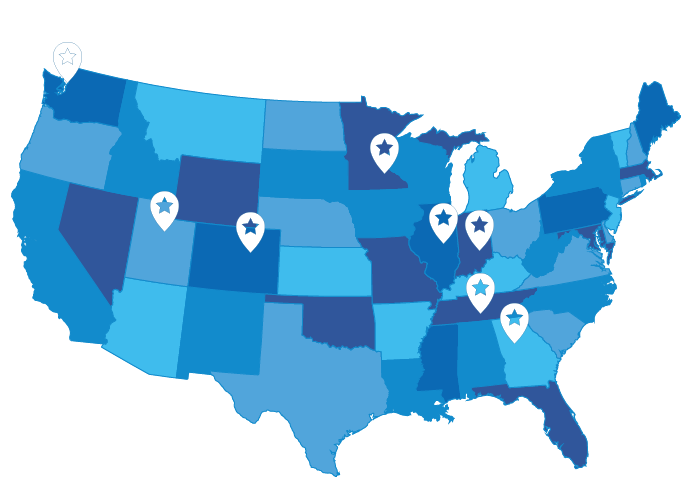Minneapolis: building bicycle and pedestrian infrastructure for low-income communities

Bicycling as a mode of travel has increased more than 78 percent since 2007, and new bicycle and pedestrian infrastructure is providing transportation access to the economically disadvantaged. The construction of more than 100 miles of bicycle and pedestrian infrastructure since 2007 has given 28,300 people of color, 2,800 people living under the poverty line, and 922 households without access to vehicles walking and bicycling facilities within one-quarter-of-a-mile.
The Minneapolis–St. Paul region continues to expand an already well-connected network of bicycle and pedestrian infrastructure using comprehensive planning, innovative approaches and collaborations between non-profit organizations and agencies. This coordinated effort generates benefits for neighborhoods and for the larger region. More than four percent of Twin Cities residents bicycle to work, on a system of over 167 miles of bikeways. The region was first in the nation to launch a large-scale bike sharing system, through an innovative partnership with the federal NTPP program, the Minneapolis Health Department and the long-term commitment of Blue Cross Blue Shield. An important goal of the Nice Ride bicycle sharing system is reducing health disparities for low-income neighborhoods in Minneapolis, which resulted in significant investments made to the Near North neighborhood.
Several organizations are working to ensure that bicycle and pedestrian infrastructure improvements are occurring in the most disadvantaged communities. SPOKES Bike Walk Connect is a community bike and walk center located in Minneapolis that is committed to growing a more diverse and informed population of bicyclists and pedestrians. It has an established record of working with the East African Community in the Minneapolis area. This year, SPOKES became part of Cycles for Change in Saint Paul, melding their similar programming and existing collaborations. Cycles for Change brings a long, established record of working with the Latino/Latina community. The two non-profits working together are expected to further empower a diverse community of cyclists in the region.
A consortium of organizations is working to make sure bicycle and pedestrian investments reach underserved communities, including Transit for Livable Communities, University of Minnesota, Nice Ride, Minneapolis Bicycle Coalition, the Alliance for Metropolitan Stability, St. Paul Smart Trips, SPOKES/Cycles for Change and others.
Minneapolis became the first city to launch a large-scale bikeshare program when Nice Rice opened in June 2010 with $2.8 million in start-up funding from the Bike Walk Twin Cities program and Blue Cross Blue Shield as a title sponsor.
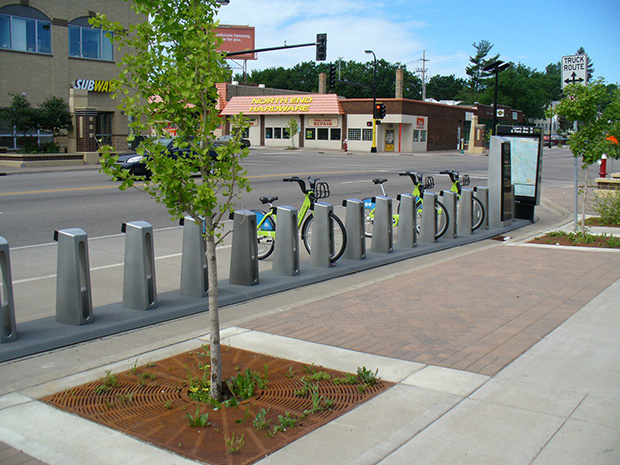
Further collaboration on bike sharing occurred with the Minnesota Health Department partnering with Nice Ride in efforts to expand the bike share system to the Near North community in Minneapolis — the Near North community is a diverse, low-income community where many of its residents experience large health disparities that include lower physical activity levels and access to care facilities. With the funds, eight bicycle kiosks were placed in the neighborhood, which in 2011 led to 4,831 trips taken by the bike share to and from Near North. The average trip duration of 22.2 minutes provided riders more than two-thirds of their recommended daily physical activity levels, according to CDC-funded research. To magnify the impact for future efforts, recommendations included offering larger community engagement strategies and making bike share subscriptions more readily available through convenient physical locations, rather than only online.
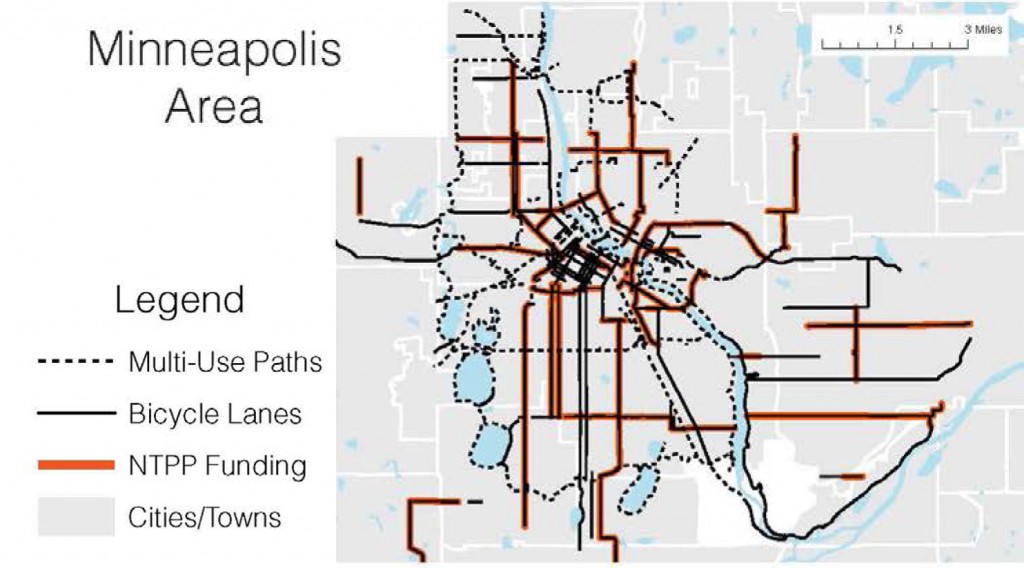
Image on the right: http://www.fhwa.dot.gov/environment/bicycle_pedestrian/ntpp/2014_report/hep14035.pdf; pg. 7 The orange lines on the map show new bicycle and pedestrian infrastructure funded by Bike Walk Twin Cities. The chart shows access to bicycle routes.
Under the NTPP, created in the 2005 federal transportation reauthorization SAFETEA-LU, Minneapolis was one of four US pilot communities to showcase how a multi-faceted investments in bicycling and walking effect use, safety, health and air quality. The pilot provided impetus for the collaboration that became Bike Walk Twin Cities and was administered by Transit for Livable Communities (TLC), a non-profit that promotes equity and access in transportation decision-making for the Minneapolis and St. Paul region. TLC allocated $28 million over seven years to planning, infrastructure, innovative programs, bike walk centers, bike-sharing, outreach, and measurement.
When the pilot began, Minneapolis had a large number of off-road trails, but there were few on-street facilities. Through Bike Walk Twin Cities, Minneapolis and 15 surrounding communities were awarded funding to create walking and bicycle facility connections to existing off-road facilities.
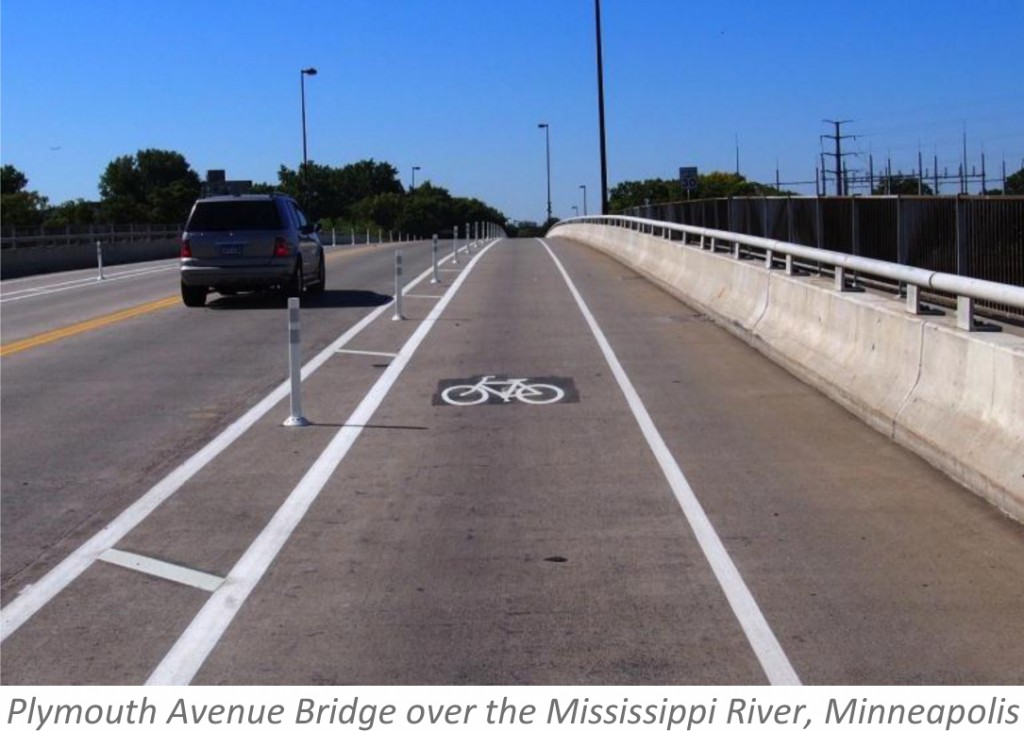
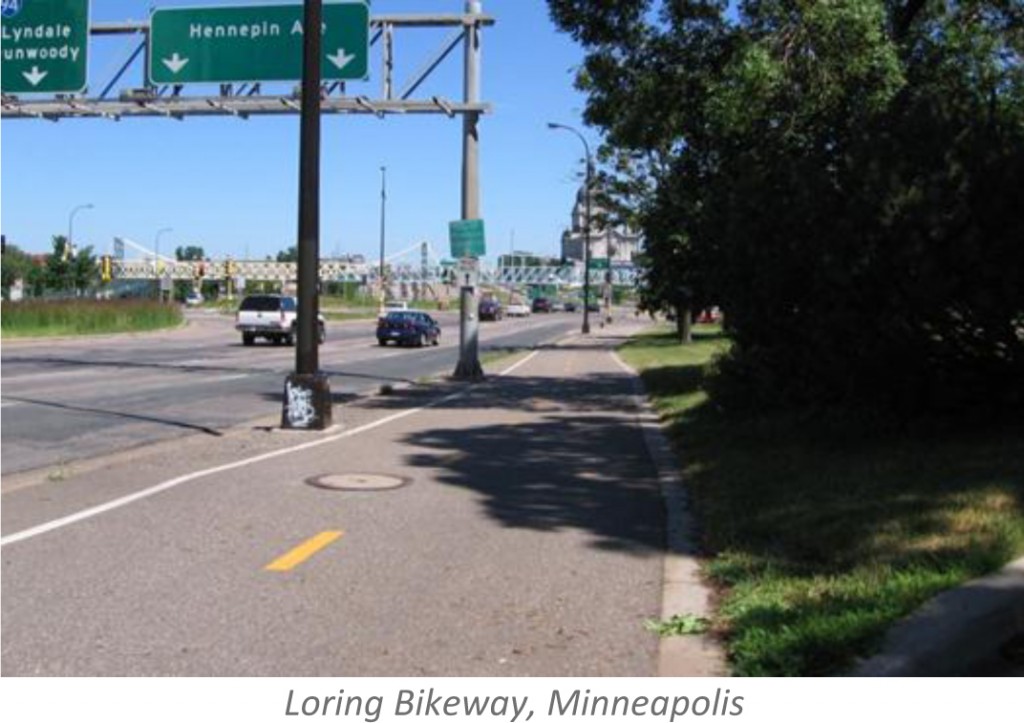
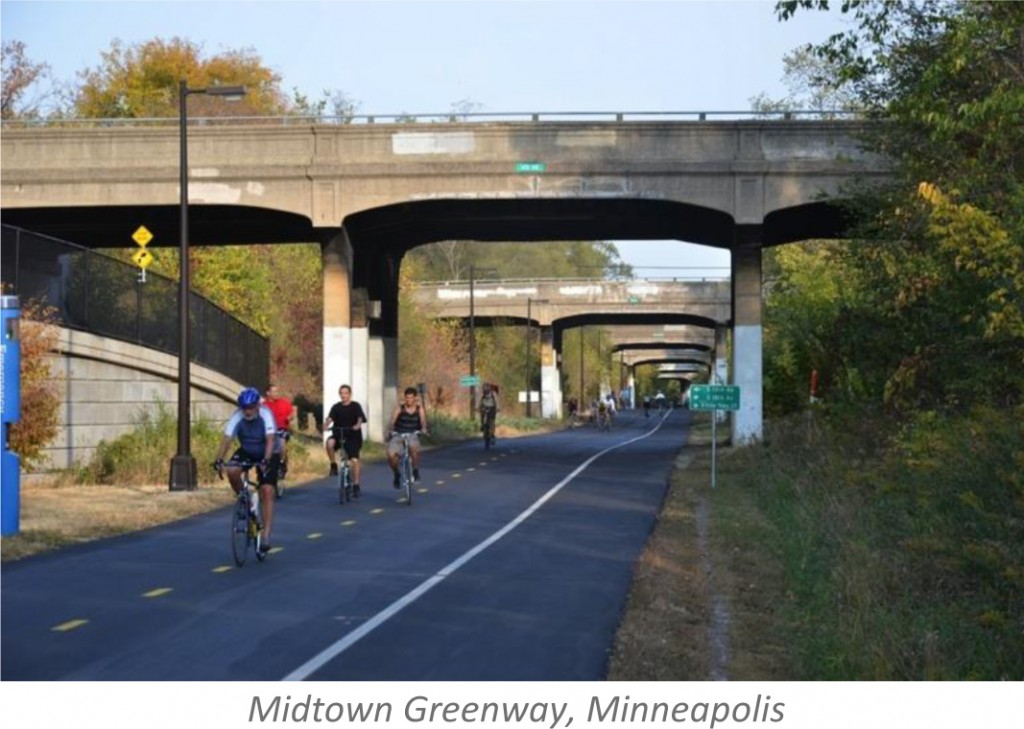
The goal was to create a cohesive system, with access and equity as strategic priorities in programming funds. Funds went to planning and project implementation for multi-jurisdictional, community-wide networks of bicycle and pedestrian infrastructure – over a 100 miles of bicycling and pedestrian improvements and 11 intersection improvements were made to the network over the course of seven years. The direct result is measured most directly through the substantial growth of users — from 2007 to 2013 bicycling use increased 78 percent, pedestrian counts were up 16 percent, and non-motorized travel counts as a whole jumped 45 percent.
Underserved communities — defined as having a higher proportion of people of color, people below the poverty line, and people without access to vehicles — benefited the most from the program funds, and overall access to bicycle and walking facilities increased for all people in the Minneapolis area from 32 percent to 48 percent, a survey of participants found. Within one-quarter-of-a-mile of new bicycle and pedestrian facilities 28,300 residents of color, 2,800 people living under the poverty line, and 922 households without a vehicle benefitted.
Bike Walk Twin Cities also launched the Community Partners Bike Library, a program that provides six-month bicycle loans, classes, and support for low-income residents to gain access to bicycle transportation. The popular program is oversubscribed, with demand for bicycles exceeding the annual supply. Also from that survey mentioned above, 96 percent of patrons experienced health benefits; 77 percent saved money by using their Bike Library bicycles; 35 percent used their bicycles to get to work; 30 percent to look for work; 26 percent to attend school and 28 percent to attend English language learning classes. Since the end of the pilot program in 2014, Transit for Livable Communities has launched a new program, Transportation Options, focused on addressing transportation as a basic need for clients of social service organizations.
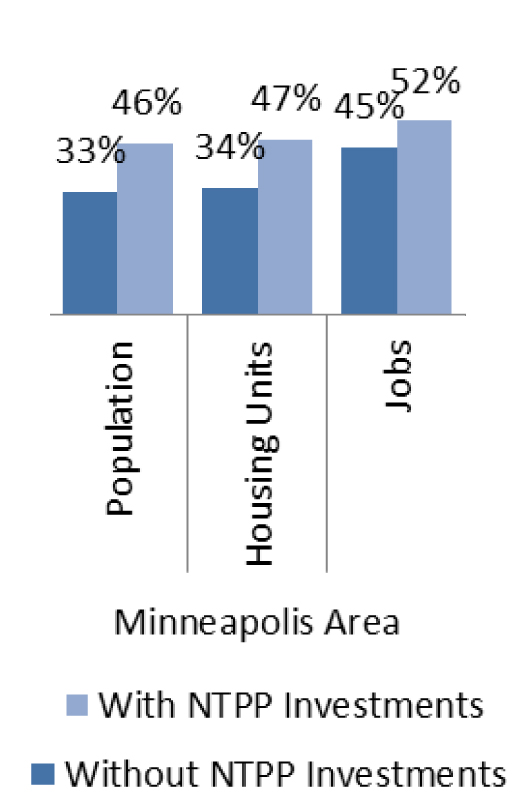
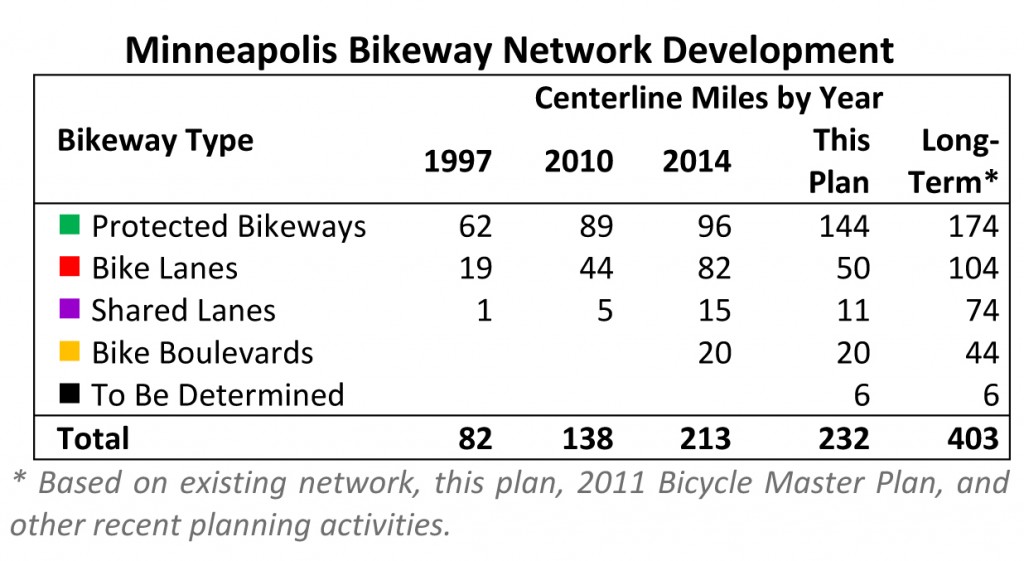
Donald Pflaum, a transportation planner for the City of Minneapolis, vows that by 2020 nearly every Minneapolis city resident will live within a mile of an off-street bikeway and one half mile from a bicycle lane. The focus on geographic, demographic, and modal equity was taken up as a central component of the Minneapolis Bicycle Master Plan published in June 2011, and there is acknowledgment that a great amount of work still remains to be done. “The system still lacks sufficient off-street facilities in North Minneapolis, Northeast Minneapolis, and south of Minnehaha Creek,” he said. The bicycle plan makes it a priority to identify projects in these parts of the city in order to ensure geographic equity.
At a regional scale, equity considerations are now being taken into account on all transportation investments.
Recognizing the existing disparities, Metropolitan Council (the region’s Metropolitan Planning Organization) recently came up with a new method for distributing transportation dollars from the federal level. The formula for allotting $150 million to potential road, bus, bike, and pedestrian infrastructure projects on a point scale determines projects to be funded based on several criteria, one of which now incorporates how a project connects to and benefits disadvantaged populations. Applicants for funding for all transportation investments, including bicycling and pedestrians projects list project benefits for low-income populations, people of color, children, those with disabilities, and the elderly. Their answers will account for part of the score for determining which bicycle and pedestrian projects are selected for funding. This new approach, bolstered by the efforts of non-profits and local organizations in the community, will continue to ensure that future bicycle and pedestrian infrastructure benefit those who need these facilities the most and that the bicycle and pedestrian network continues to cohesively connect neighborhoods in the Minneapolis and Saint Paul region.
- To view a list of projects and the list of strategies under the Bike Walk Twin Cities program:
http://www.bikewalktwincities.org/about-us/funding-process-and-history/projects - To view a summary of the outcomes for safety, access, and mobility for projects funded under the NTPP program:
http://www.bikewalktwincities.org/news-events/news/ntpp-report-congress-shift-bicycling-and-walking-comes-infrastructure





